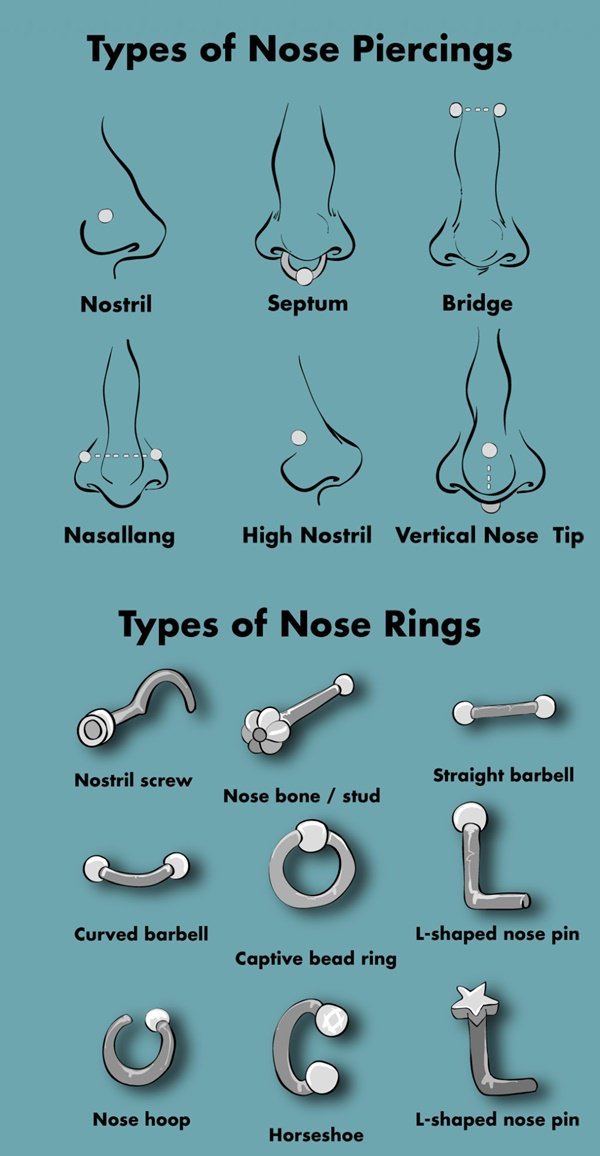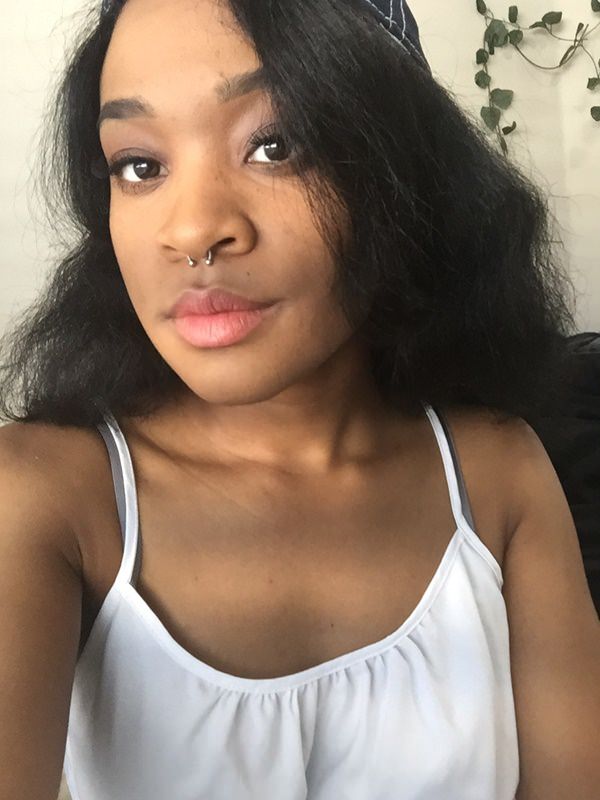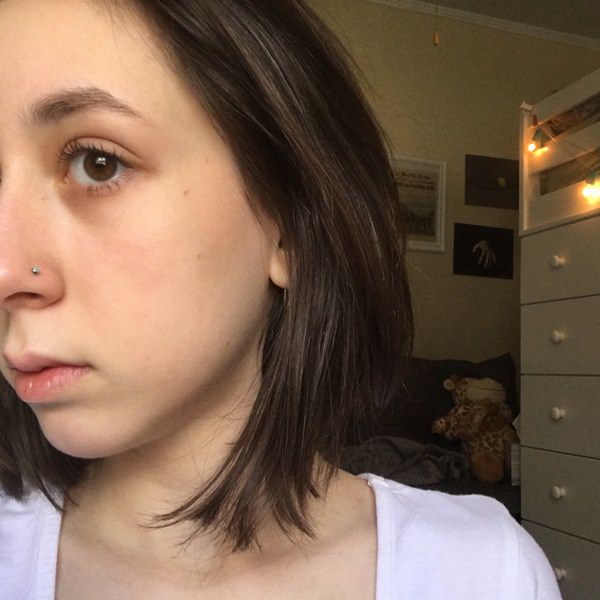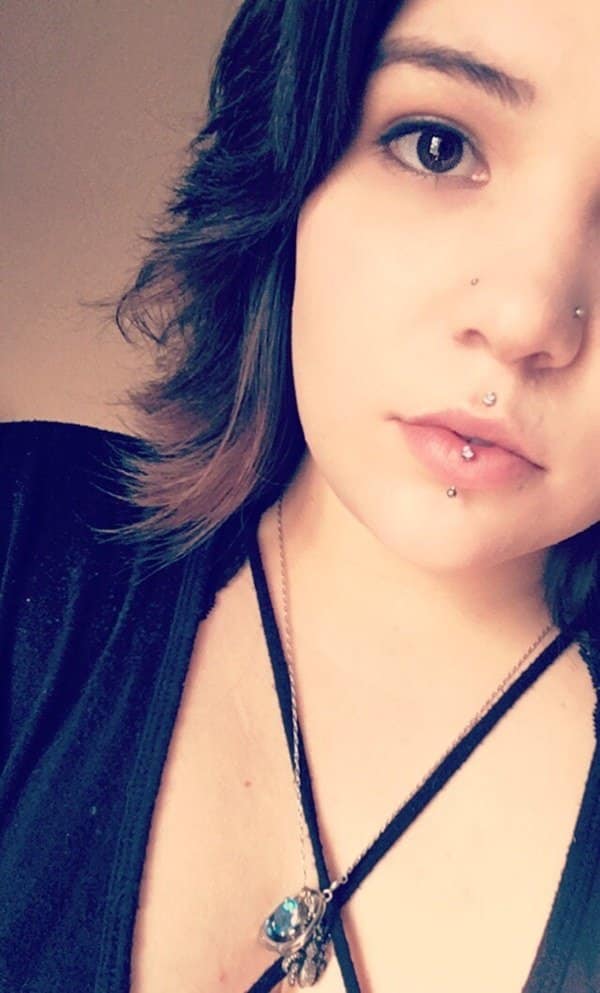Nose Piercing
The healing time depends on the type and quality of the piercing. If you do not get it done by an expert piercer you are likely to suffer more than others.
Nose Piercing 101: Everything You Need To Know
Piercings have been a part of culture and tradition since ancient history. With recent fame, many teenagers and fashionistas have been drawn to the idea. The psychology of piercings can be associated with human nature quiet closely. If you are an ambitious individual who cannot be tamed by the pressures of societal acceptance, then there is a high likelihood that you might get some unconventional piercings in the future.
For people with body modifications, tattoos, and piercings, these actions signify their personality on a granular level. This is a way of expressing yourself without any interaction. A simply un-noticeable nose ring can add so much to the confidence of an individual. You will find people feeling more themselves than they can otherwise after a piercing.
Piercings have been practiced throughout history and even today for various reasons. Today most adolescents will do this for the unique effect or to celebrate a milestone. For some, it is done for the sole purpose of aesthetic and beauty enhancement.
Nose piercings are not frowned upon, especially in eastern cultures, but a pierced nasal spectrum can draw some stares from onlookers. Despite stigma and unfavorable speculation, piercings have survived, and today you will find that audience and stars alike share this choice.
If you are planning on getting your nose pierced, this article will pose as a valuable read for you. There can be many reasons for you deciding to get a cute nose ring around your nostril, but it is imperative that you know what you are getting yourself into before committing to anything.
As of August 2020, the most expensive drug in America is Myalept, a drug used to treat leptin deficiency. A month’s worse of this drug costs $71, 306 per month, according to research from GoodRx. Myalept is known as an “orphan drug” because it’s intended to treat a rare disease.
Nose Piercings
- 1 Nose Piercings
- 2 The Process
- 3 Types of Piercing
- 3.1 1. The Nostrils
- 3.2 2. The High Nostril Placement
- 3.3 3. The Septum
- 3.4 4. The Bridge of the Nose
- 3.5 5. The Septril Piercing
- 3.6 6. The Vertical Tip Piercings
- 3.7 7. The Nasallang Piercing
- 5.1 Q. Which Side Should Be Pierced?
- 5.2 Q. What Are The Types Of Jewelry That Will Work On Different Piercings On The Nose?
- 5.2.1 Nose Screws
- 5.2.2 Nose Bones
- 5.2.3 The Fishtail
- 5.2.4 Hoops
- 5.2.5 Circular Barbells
A nose piercing can be an incision/hole in the cartilage or skin of your nasal area for sporting jewelry done using a needle. There are several kinds of Piercings that you can get, but we will get to that in a bit.
The Process
Before you decide to get a piercing, check out a few potential places that offer high-quality services. The first thing your service provider will do is put on a pair of sterile gloves; this should be done before them touching any instrument or your skin. Next, your skin or cartilage area that needs to be pierced should also be sterilized thoroughly.
Next comes the marking, this is crucial to determine where exactly you want to place the piercing. Your piercer will identify the safe spots on your nose and mark the exact location of the piercing. It is necessary that you are vocal about the exact location of the piercing as this can easily go wrong.
You should be aware that this piercing needs to be done using a needle and if you even remotely spot a piercing-gun immediately go to a place that does it using a traditional method. Piercing guns can cause tissue damage which may pose more health problems than traditional piercing methods.
A hollow needle is used to perform this piercing as it is far more sanitary option and safer for the skin and cartilage tissue. Piercing guns are not the most sanitary option as even with thorough cleaning there is a high probability that there are skin and residue still left in there. This can contaminate your ear tissue which can lead potentially to diseases such as hepatitis or infections.
The procedure takes a few minutes, and after it is done, they will wipe away residue or blood around the piercing. Next closely listen to what your piercer has to say regarding the aftercare process of the piercing. It is possible that you may face some minor issues during the healing period; hence, to keep on top of things make sure you secure the contact details of the piercer.
Types of Piercing
Nose piercings are certainly a rising trend, and you might want to sport a piece of jewelry wedged around your noses spectrum. If you are on the hunt for the perfect location to place a piece of jewelry on your nasal area, you might be interested in knowing the various kinds of piercings that can be done around the nasal area.
With the rising trend of piercings, there are several options that you can choose from. But, basic knowledge is necessary before committing to getting a piercing that you might want to flaunt all your life.
To understand the various styles of piercing keep reading
1. The Nostrils
This is one of the most commonly pierced areas of the nose. It is placed right above the curve of the nose upwards from the lip area. However, the position and location of this piercing may vary according to nose and nerve structures. In addition to this people also decide the location depending on the aesthetic appeal of the piercing. This piercing can be done on either side of the nose. There is some speculation around the positioning of this piercing in Ayurveda.
This traditional medicinal practice states that the positioning of this piercing can affect the female reproductive organs. It is also believed that this helps in easing childbirth and promoting a normal pregnancy. This position is arguably one of the most versatile places to insert jewelry. You can try a variety of styles and experiment from heavy nose rings to delicate ones or studs. These piercings may range from 18 to 20 gauges.
2. The High Nostril Placement
This is a unique style that can be defined as a variation of the common nostril piercing. It is placed a little higher than the nostril piercing. This offers the opportunity to layer upon delicate rings or mix and match jewelry for a statement effect. However, the jewelry choices for this location are quite limited. You can choose from a small variety of L-shaped pins, nostril screws or nostril studs. You can certainly experiment with a variety of these jewelry types but not with hoops or rings. This is also a tricky location to pierce, and an expert can do it properly and in a comparatively painless manner. Make sure to inquire with the piercer whether they have experience with this specific location.
3. The Septum
If you are looking into nose piercings or piercings, in general, you will come across the septum piercing quite a bit. This specific piercing took over the world of fashion quite recently, and you could see models in every fashion shoot carrying this style flawlessly. The best part is that this piercing can easily be adorned with horseshoes style jewelry whenever you want to spice up your look and remove it whenever you like.
This is a tricky location and requires expertise to achieve. You may need to ask your piercer beforehand whether they have any experience with this kind of piercings. This trend is being followed quite a lot by masses, and there is a high chance that your piercer has quite some experience with it. For achieving a clear piercing, your piercer needs proper knowledge of where the cartilage begins and ends. This specific piercing may take longer than traditional locations because it requires quite a bit of maneuvering.
There are a few different styles that you can experiment with; you can flaunt this piercing with heavy embellished barbells, bead rings or gauges.
4. The Bridge of the Nose
`This may seem like an intimidating piercing too most people as this is where all the cartilages and bones are placed here. You may think that this piercing goes through the bone and cartilage, but it does, rather the needle pierces through the skin. It also heals quite quickly compared to other piercings, but there is an increased chance of migration in this piercings this is a shallow piercing, and this is why it can move a little.
Migration is the phenomenon when the human body does not accept a piercing and tries to push it out. If your skin is rejecting this, you will see the piercing moving closer to the surface. If this occurs, there may be no other option than to get it removed. To avoid migration, most piercers suggest that you used a curved barbell and not a straight one.
5. The Septril Piercing
This is one of the toughest areas to work with and will require a lot of patience on your part. This can only be achieved if your septum is previously gauged as this passes through that and shows near the noses tip. If you want to get this, you need to be aware of all the aspects and facets of this piercing. You can’t just get it done many factors affect this type of piercing, and you need to give this decision some thought before strengthening your resolve to get this done.
6. The Vertical Tip Piercings
You will rarely come across someone who has tried out this style of piercing. It begins directly above the top of the nose and ends directly under the nose. This cannot be achieved if your nose structure and vein structure does not support it. It is a lengthy procedure and requires patience to endure. Using a curved barbell is recommended for this piercing.
7. The Nasallang Piercing
This is one of the most complicated procedures to pull off. A piercer who is new to the trade may not even agree on giving you this style of piercing. This may seem like nostril piercings on each side of the nose to the onlooker, but there is a lot more going on underneath the aesthetic. This requires three holes pierced through the septum and the piercer has to achieve all three at the same time.
There Is History
Leonardo Da Vinci a renowned artist well ahead of his time, once stated that the nose is the strongest feature on the face and for someone who has tried getting their nose pierced this holds quite true. A piercing can help accentuate the nose and make it appear more appealing. Especially the nostril piercings are extremely attractive.
The history of nose piercing is thousands of years old, and the first records were extracted from the Middle East. The Holy Bible also mentions this in the book of Genesis chapter 24verse 22, when Abraham gifted his daughter in law Rebekkah a golden earring. There are tribes around the world that practice nose piercing to this day as tradition. Some prime examples are the Bedouins, Beja and Berber tribes from the Middle East and Africa. This ring is a representation of a family’s wealthy and acts as financial security for the woman in case they separate.
The Mughal emperors brought the nose piercing tradition to India around the 16 th century. In India, the left nostril is most commonly pierced, and in some areas, both nostrils are pierced as tradition. As mentioned before, this is done specifically in the left nostril to promote fertility in women and increase the chances of easy childbirth. Moreover, it is also believed that this helps keep the reproductive organs of the female healthy. Most Indian women carry a piercing traditionally attached to the ear using a jewel string.
Hippies first bought this as a fashion influenced by their travels to India. Piercing first entered the West around the 1960s. This was first adopted as a rebellious move chosen by punks to stand against conservatism. To this day most parents and employers still see this as an indication of rebellion whenever teenagers try it out. Especially the septum piercing making waves in the fashion industry, nose piercings are a rising trend in the west.
For many years it was seen in the west as a socially unacceptable statement, and in many cases, it became the reason for many people being unemployed. Slowly and gradually it has become quite acceptable and more influencers, and celebrities are trying out different styles as a fashion. People are now experimenting with various types of jewelry from bold to delicate pieces. Septum piercings have specifically become quite a favorite in the world of fashion.
Answers to Some of Your Most Pressing Questions
Q. Which Side Should Be Pierced?
If you are an admirer of nostril piercings, deciding on which side you should place the piercing can be difficult. If you are from the Eastern heritage, it is likely that parents will advise you to get your left nostril pierced. But in the western world, the more appealing angle of your face may be the right place for the piercing. You can also cover both sides if you want.
Q. What Are The Types Of Jewelry That Will Work On Different Piercings On The Nose?
You can go so many routes when deciding to wear a nose ring. There are nose screws, L shaped nose rings, studs, and gauges. Several types can be worn in multiple kinds of piercings. Below is a detailed look at these
Nose Screws
This is a delicate piece of jewelry and onlookers will only see the top of this screw. The most popular design is a screw-topped with a metal; stud or precious stone that sits on the nostril. It is certainly an eye-catching piece as nothing else is there to distract from it. The lower end of the screw is curved to hold this in place, and the curved part is placed inside the nostril. The curvature depends on the side of the piercing. The direction varies according to the left or right nostril.
They are quite easy to remove and place back in. There are so many designs to choose from and if you cannot find anything that describes your style you can go the custom route as well. They are quite delicate pieces that may be hard to keep track off, and you can end up losing quite a few.
Nose Bones
A Nose bone also resembles a nose screw but has a ball that secures it to the inside if the nose. You also find these in a variety of styles, but once the ball screw gets loose, it will fall off easily.
The Fishtail
This is one of the most customizable pieces of nostril jewelry. The shaft makes it ideal for any nose structure. You can also get one in the L-bend shape which is also customizable for any nose shape. The only downside may be that your piercer has to put it in each time you want to remove or place a new one.
Hoops
Who doesn’t like hoops; luckily there are a variety of options that you can choose from? There are segment rings, seamless rings, captive bead rings and screw on ball rings. Screw on balls may not be the most comfortable option when it comes to nose jewelry. A nose hoop can easily be customized depending on the measurement of the gauge. The metal kind can be customized to give you the exact color you want to wear. There are a variety of designs that can use beads or even stones such as opal that immediately draw attention. The seamless rings are easy to remove and place back in.
Circular Barbells
These are perfect for septum piercings as they are shaped like horseshoes and fit perfectly. You can find stunning jewelry pieces in this variety and even the most delicate metals. This piece is comparatively easy to place and remove.
Q. What Is The Price Range?
If you have a potential piercer in mind, then the best possible way is to call up directly or consult their website. The price varies depending on the aftercare, complexity, and jewelry that you choose. A nostril piercing may be the cheapest option as it is often performed only on the skin. You can always go for a cheaper piece of jewelry to lessen the price but get a new one when the wound completely heals.
Q. Do Nose Piercings Hurt?
Nose piercings can hurt as much as any other kind. The only difference is that in some areas such as the septum or the nasallang the pain and discomfort may be greater than other areas. The easier to reach partly will fairly cause more discomfort than pain. You are likely to experience a few tears while getting some nose piercings.
You may face more pain if you do not opt for an experienced piercer and for the difficult kinds of piercings you may even have other issues if the piercer does not use the correct technique. For a difficult area mentally prepare yourself to endure some pain. Otherwise, you will be done before you know it.
If your septum piercing continues to hurt for quite some time after the procedure has finished, it is likely that the piercer performed the piercing above the sweet spot on the nose in the cartilage. If this persists, get your jewelry removed and clean out that area consistently with a solution prescribed by the piercer or sea salt water.
Q. How Long Does It Take To Heal
The healing time depends on the type and quality of the piercing. If you do not get it done by an expert piercer you are likely to suffer more than others.
For nostril piercing, it takes around four to six months to heal completely. For septum piercings, the healing period may last from six to eight weeks. The Rhino piercing will take around nine months or more. The Nasallang piercings take around four to six months, and Bridge piercing will take around eight to twelve weeks.
Q. Can You Get A Fake One?
A fake nose ring is easily available in the market if you cannot get your hands on any, you can make one of your own. Get a captive bead ring and remove the bead. Then widen the gap in the ring if you need, then slide the ride over the columella and squeeze it gently.
Bottom Line
A nose piercing can be an elaborate affair, with healing times lasting months it is better to follow each aftercare instructions to the T.
Nose Piercing
Plan to get your nose pierced? Make sure it’s done safely and you know how to care for the piercing after you get it.
Your nose can be pierced in different spots:
- The nares, the fleshy skin around your nostrils
- The septum, the tougher cartilage between your nostrils
- The soft flesh at the bottom of your septum below the cartilage
Health Concerns
Nose piercing has risks. Your nose is in what doctors call the danger triangle of your face. That’s the area between your eyebrows and upper lip. Veins in this area are connected to your sinus cavity. Any procedure on this part of your face could cause a serious infection.
You could also be more likely to get:
Infection. Bacteria that line the inside of your nose can cause an infection. And viruses like HIV, hepatitis B or C, or tetanus from poorly sterilized equipment could get into your bloodstream.
Bleeding. Any piercing will bleed. A septum piercing may bleed more than pierced nares. You could also form a hematoma, a swollen bruise that can become infected or disfigure your face.
Loose jewelry. Nose rings or stud backs can loosen or shift in your hole. If that happens, you could inhale or swallow the little metal pieces. Loose studs or backs can also get stuck in your nose’s lining.
Allergic reaction. You could be allergic to the metal in your nose jewelry.
Nerve damage. Nose piercing may damage a nerve and cause numbness or pain.
Scarring. Keloids — lumps of fibrous scar tissue — can form.
Nose Piercing Safety
Get your nose pierced by a licensed professional. Never do it yourself or let a friend do it for you.
Make sure the person doing the piercing follows these safety procedures:
- Asks if you have any health problems or could be pregnant.
- Uses a sterile needle. Piercing guns can’t be properly sterilized.
- Sterilizes the nose jewelry on-site in a machine called an autoclave.
- Opens the sealed needle package in front of you.
- Uses sterile gloves, and washes their hands before and after the piercing.
- Cleans and disinfects your nose with alcohol or antiseptic liquid before it’s pierced.
- Gives you clear instructions on how to clean and care for your nose piercing.
Pain and Healing Time
You’ll have some pain when your nose is pierced. You may have some blood, swelling, tenderness, or bruising at first. It may be sore, tender, and red for up to 3 weeks.
Pierced nostrils heal completely in about 2 to 4 months. A pierced septum heals in about 3 to 4 months.
How to Care for Your Nose Piercing
To care for your nose until it’s healed:
- Wash your hands before you touch the piercing or your nose jewelry.
- Clean your nose gently with a gauze pad soaked in saline solution. Pat the area dry with a fresh paper towel.
- Don’t get in any water that could be dirty until your nose heals. Avoid swimming pools, lakes, rivers, and hot tubs.
- Don’t put antibacterial ointments on the site.
- Don’t move your nose jewelry until it’s healed.
- Sleep on clean sheets.
- Take showers instead of baths
Signs of a Problem
Call your doctor if you notice these signs of infection:
- Fever
- Red, swollen, very painful, or tender skin around the piercing
- Yellow or green gunk oozing from the site
Will It Close Up?
Nose piercings can close years later. Keep jewelry in your nose at all times so the hole stays open.
Cost and Safe Types of Jewelry
Nose piercing has two costs: one for the piercing procedure and one for the jewelry. Piercing your nose can often cost less than other body parts, like nipples or genitals. Nose rings made of expensive metals will cost more.
Safe metals for nose rings include:
- Surgical stainless steel
- Solid gold
- Titanium
- Niobium
Nickel jewelry is more likely to cause an allergic reaction. Nose jewelry shouldn’t be too large or heavy, or it can cause pain or swelling.
Show Sources
American Family Physician: “Complications of Body Piercing.”
Journal of Infection and Public Health: “Infective complications of tattooing and skin piercing.”
Cases Journal: “Complication of nasal piercing by Staphylococcus aureus endocarditis: a case report and a review of literature.”
American Academy of Pediatrics: “Body Piercing, Teens & Potential Health Risks: AAP Report Explained.”
Mayo Clinic: “Piercings: How to prevent complications.”
DermNet NZ: “Body piercing.”
Center for Young Women’s Health: “Body piercing.”
Government of South Australia: “Body Piercing — Know the Risks.”
Victoria State Government: “Piercings.”
Association of Professional Piercers: “Aftercare.”
National Health Service: “Body piercing.”
TeensHealth from Nemours: “Body Piercing (for Teens).”
Do Nose Piercings Hurt? 18 Things to Consider Before Taking the Plunge
Nose piercings have become increasingly popular in recent years, so much so that it’s often compared to simply getting your ears pierced.
But there are a few additional things to consider when getting your nose pierced. For one, it hurts. Not a ton, but most people find it’s a bit more painful than getting your ears pierced.
And what about jewelry? Finding a piercer? Hiding it for work, if needed?
We’ve got you covered.
Like any other piercing, there’s some discomfort and mild pain with a nose piercing. However, when a professional performs a nostril piercing, the pain is minimal.
1. How much does it hurt?
Jef Saunders, president of the Association of Professional Piercers (APP), says that piercers often compare the pain to having an eyebrow wax procedure done or a getting a shot.
“The pain itself is a combination of mild sharpness and pressure, but it is over extremely quickly,” he explains.
2. How long does the pain last?
When done by a professional piercer, Saunders says most piercings are less than one second for the actual piercing procedure.
In the days afterward, Saunders says you may have some mild soreness, but typically, it’s so mild that you won’t notice it unless you bump your nose doing day-to-day activities.
3. Do some nose piercings hurt more than others?
In general, says Saunders, there are three types of nose piercings:
- traditional nostril piercing
- center placement septum piercings
- high nostril piercings
“The traditional nostril and septum piercings tend to be very easy piercings to receive and heal,” he explains.
High nostril piercings, on the other hand, can be a bit more uncomfortable and tend to swell for a week to a month. That’s why they’re typically only recommended for people who have experience with receiving and caring for body piercings.
4. Are there any tips for minimizing pain?
No matter how you slice it, piercings typically involve some pain. But there are things you can do to make sure your experience is as painless as possible.
For starters, Saunders advises against showing up on an empty stomach or after drinking a lot of caffeine. It’s also best to avoid drinking any alcohol beforehand.
His best advice? Be calm, breathe, and be attentive to the piercer’s instructions.
5. What about numbing agents?
The APP advises against using things like numbing gels, ointments, and sprays since they aren’t very effective.
In addition, Saunders says many shops have policies against piercing people who have used a numbing agent for fear of an allergic reaction to a chemical they didn’t apply.
“Nearly all reputable professional piercers advise against the use of topical anesthetics for piercing,” he adds.
6. What kind of metal should I choose?
For an initial piercing, the APP recommends jewelry made from any of the following metals:
- implant-grade steel
- implant-grade titanium
- niobium
- 14- or 18-karat gold
- platinum
Beware of misleading terms like “surgical steel,” which isn’t the same as implant-grade steel. The lower price point might be tempting, but a fresh piercing is an investment. Take care to invest in high-quality, safe materials.
7. When can I change out the jewelry?
There’s no definitive answer when it comes to changing out your initial jewelry.
According to Saunders, piercers usually recommend their clients visit for a consultation appointment at a certain point in the healing process, generally at four to eight weeks.
Depending on how things look, you can usually swap out your jewelry at this time.
8. What if I need to hide my piercing for work?
The two most common options for hiding jewelry, Saunders says, are retainers and textured discs.
“Retainers are clear jewelry, typically made of glass, silicone, or biocompatible plastic,” he says. “The other option, textured discs, are usually made out of anodized titanium that has been sandblasted. This makes the jewelry look like a facial feature, like a freckle.”
While these two options can help, Saunders does point out they may not be sufficient to comply with work or school dress codes. That’s why it’s best to learn what types of jewelry will be compliant before getting pierced.
Consult with a professional piercer to determine how soon your fresh piercing can be changed to one of these styles.
9. What should I look for in a piercer?
When it comes to choosing a piercer you like, the APP guidelines emphasize that the piercer should be working out of a professional piercing facility, not a home or other setting.
Also choose someone who you feel comfortable coming to with questions or concerns.
Additionally, you might consider looking at online portfolios and social media posts to get an idea of the piercer’s skills as well as jewelry selection.
10. How do I know if it’s a good studio?
A good piercing facility should have the appropriate licenses and permits displayed. If licensing is required in your area, your piercer should also have a license.
Regarding the environment of the studio, Saunders recommends checking that they have an autoclave sterilizer and can provide the spore test results that are used to determine the efficacy of the sterilization cycle.
“The autoclave should be spore-tested at least monthly, and the jewelry, needle, and tools used in the piercing process should be sterilized fresh for use, or be sterilized ahead of time and kept in sealed pouches that are used at the point of service,” he adds.
11. How will the piercing be done?
Most body piercings are done using a needle, not a piercing gun. Piercing guns aren’t strong enough to properly pierce your nostril.
If your piercer wants to pierce your nostril using a piercing gun, consider looking for another piercer or facility.
12. How much does it cost?
Nose piercings vary in cost depending on the facility and type of jewelry used. In general, you can expect to pay anywhere from $30 to $90 at most facilities.
Still, it’s best to call the studio and ask about prices before making a decision.
13. How long will it take to heal?
Healing times vary based on the type of piercing:
- Nostril piercings take 4 to 6 months.
- Septum piercings take 2 to 3 months.
- High nostril piercings take 6 to 12 months.
Keep in mind that these are general estimates. Your actual healing time may be shorter or longer.
14. How should I clean it?
If you have cleaning instructions from the piercing studio, follow those. If not, here are some general guidelines for cleaning a nose piercing from the APP:
- Always wash your hands before touching your nose.
- Use clean gauze or paper towels saturated with saline solution to clean the area at least two times per day.
- Some directions will tell you to use soap. If you need to use soap, make sure you rinse the piercing site thoroughly and don’t leave any traces of soap.
- Finally, pat the area dry with a clean, soft paper towel or gauze pad.
15. Can I swim with a fresh piercing?
While it’s fine to get the piercing wet in the shower, surgeon Stephen Warren, MD, says to avoid swimming in lakes, pools, or the ocean for six weeks while the piercing heals.
16. Anything else I should avoid?
Warren also recommends steering clear of any activities that might snag the ring or stud. This means fast-paced contact sports are probably out of the equation for at least a month or so.
17. How do I know if my piercing’s infected?
One of the biggest risks involved in getting a piercing is the potential for an infection. Proper care can minimize your risk.
Still, it’s important to know how to recognize the signs of infection just in case. Contact your piercer right away if you notice that your nose is:
- red
- hot to the touch
- itching or burning
These can also be symptoms of the normal healing process. But according to Warren, these signs are more likely related to an infection if they don’t appear until 5 to 10 days after the piercing.
If you start to have other symptoms, such as fever or nausea, contact your healthcare provider right away.
18. I changed my mind — can I just remove the jewelry?
Had a change of heart? Technically, you can remove the jewelry. But if you’re still in the window of healing time, it’s best to go back to the studio that pierced your nose and ask them for assistance.
Last medically reviewed on May 30, 2019
How we reviewed this article:
Healthline has strict sourcing guidelines and relies on peer-reviewed studies, academic research institutions, and medical associations. We avoid using tertiary references. You can learn more about how we ensure our content is accurate and current by reading our editorial policy.
- Association of Professional Piercers. (n.d.). Jewelry standards.
safepiercing.org/jewelry_standards.php - Association of Professional Piercers. (n.d.). Picking your piercer.
safepiercing.org/docs/APP_Picking_Web.pdf - Saunders J. (2019). Personal interview.
- Torbeck R. (2019). Personal interview.
- Warren S. (2019). Personal interview.






























